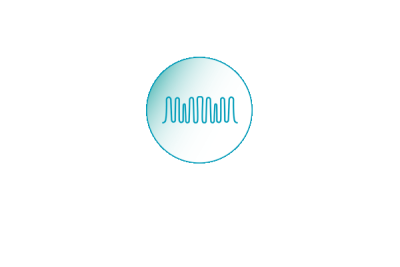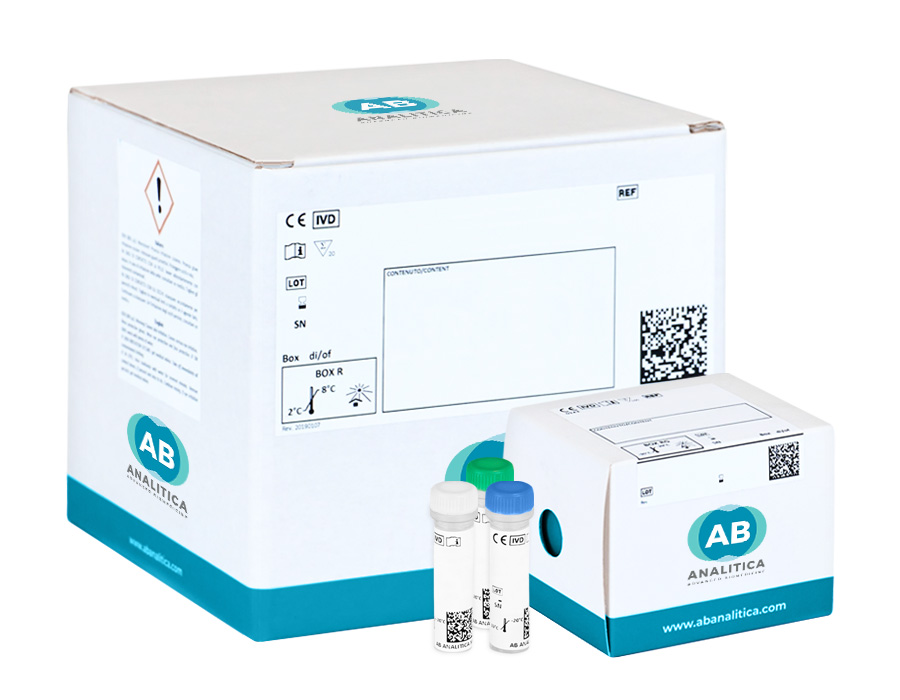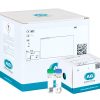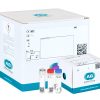Description
The GENEQUALITY CD-TYPE kit is an IVD for identification of genetic susceptibility to Celiac Disease using gene amplification and allele specific reverse hybridization (Reverse Line Blot).
The product involves a multiplex PCR reaction followed by a visualization of the amplified material with Reverse Line Blot (RLB).
Product Characteristics
- The assay requires only 5 µL of DNA extracted
- The automatic format of the assay can be used on different automatic instruments for Reverse Line Blot protocols
- Easy interpretation of results with CD-TYPE Strip Reader software
Kit content
Kit includes:
- Ready-to-use reagents for End-Point PCR
- Reference DNA
- Strips and reagents for amplicons visualization by Reverse Line Blot
- Transparent film for strip interpretation
- Strip collection sheet
- Tray with 8 single-use channels for Reverse Line Blot (only in the manual format)
- CD-ROM containing the interpretative software CD-TYPE Strip Reader, the User manual
Further Information
The Celiac Disease describes an abnormal immune response to gliadin and glutenin (gluten proteins). Normally, Celiac Disease only occurs in individuals of a certain genetic predisposition.
HLA typing is used as genetic test for susceptibility to the Celiac Disease. The typing evaluates major or minor predisposition of an individual to develop the disease. Because the presence of a certain HLA type is not sufficient to predict incidence of the disease this test has a limited diagnostic value. Additionally, certain environmental factors and other genetic factors determine the manifestation of this disease. Because the absence of risk alleles makes a disease manifestation highly improbable, the HLA gene analysis has an overall negative predictive value.
HLA typing is indicated in case of an unclear diagnosis (i.e. result of antibody test and/or biopsy unclear/discrepant) or for patients belonging to certain risk categories, e.g. occurrence of celiac disease among relatives of first degree relatives (parents, children, siblings), patients with insulin-dependent diabetes mellitus, persons with Down syndrome or with IgA deficiencies. In these cases, it is necessary to determine whether to continue the follow-up if serological findings were negative, as recommended in the national and international guidelines.
The frequency of occurrence of Celiac Disease is 20 times higher (10%) in persons with first degree relatives suffering from celiac disease than in the general population. Moreover, the concordance of the disease in monozygous twins is 84%, whereas in dizygous it is merely 17%. According to this data heritability of celiac disease is in the order of 80%.
DQ2 and DQ8 are glycoproteins expressed on the surface of certain immune cells. Those proteins are heterodimers; they are constituted by an alpha (α) and a beta (β) chain. The DQA1 and DQB1 genes code for the α and the β chain, respectively. The DQA1*05 and DQB1*02 alleles, which code for the DQ2 heterodimer, are associated with a higher risk to develop Celiac Disease whereas the alleles DQA1*03 and DQB1*03:02, which encode for the heterodimer DQ8, confer a lower risk to develop Celiac Disease.
Approximately: 80% of celiac patients have the DQ2 type (DQA1*05 and DQB1*02 allele), 10% have the DQ8 dimer (DQA1*03 and DQB1*03:02 allele) and about 5% have a DQB1*02 positive/DQA1*05 negative genotype, thus carrying only the high-risk β molecule of DQ2.
In rare cases, none of the above-described combinations are found, giving an important negative predictive significance to the test.
Therefore, testing for the DQ2 heterodimer requires to check for the presence of both the DQA1*05 and the DQB1*02 allele. The presence of both the alleles leads to a higher risk then the presence of only the DQB1*02 allele. For detection of DQ8, the presence of the DQA1*03 and DQB1*03:02 alleles are tested. It should be noted that all DQB1*03:02 genotypes carry also DQA1*03, but not vice versa.
The DQB1*02/*02 homozygous configuration is associated with the highest risk to develop Celiac Disease and was described to be also associated with other severe conditions as intolerance to diet and development of lymphoma. That configuration is found in 30% of Celiac patients and in 10% of DQ2 positive controls.
In accordance with the guidelines on the matter, the typing performed by molecular biology techniques must comprise the determination of the allelic groups: DQA1*03, DQA1*05, DQB1*02 and DQB1*03:02.
The first three group require only lower resolution typing, because all alleles of these groups confer the same risk (i.e. DQA1*05:01 and *05:05 or DQB1*02:01 and *02:02). Concerning the DQB1*03 group, it is necessary to distinguish the high-risk allele DQB1*03:02 from the DQB1*03:01 and *03:03 variants which are not associated with Celiac Disease.
Ordering Information
| Code | Product | PKG |
|---|---|---|
| 02-14A-20 M | GENEQUALITY CD-TYPE v2.0 | 20 tests |
| 02-14A-20 A | GENEQUALITY CD-TYPE v2.0 Automatic format | 20 tests |









